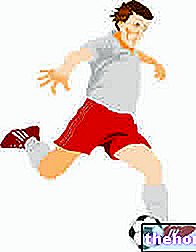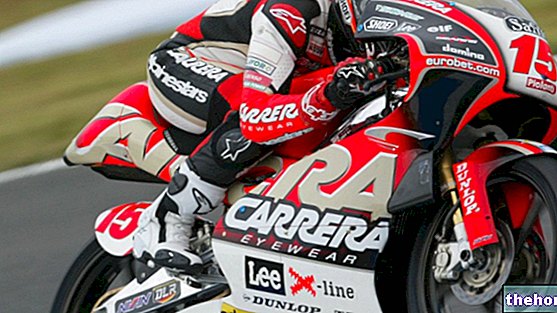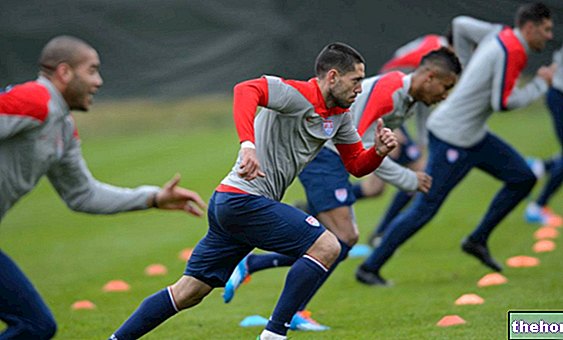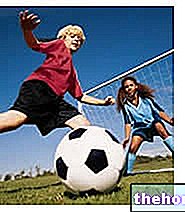When we talk about training we must take into consideration some of the characteristics that will be used to correctly set up our sessions. These characteristics are represented by the following TECHNICAL-SCIENTIFIC NOTES:
- throughout the season, if few trainings and many games are carried out, there is a reduction in VO2MAX (maximum oxygen consumption);
- the VO2MAX seems to be significantly correlated to the distance covered and the number of sprints performed during the whole game;
- to monitor the intensity of the effort of the players during the entire football match, cameras are used differently placed inside the stadium or playing field, through which the actions carried out, the various intensities, the duration in relationship to distance, frequency and exercise / break ratio;
-

on average, each player travels about 10 km per game;
- up to 1000 different activities are performed during the game, with changes every 6 seconds;
- the ratio of low-intensity to high-intensity exercises is about 2 to 1;
- the distance covered with the ball is 2% of the total distance;
- the players rest on average 3 seconds every 2 ";
- every 30 sec. c "is a sprint;
- every 90 sec there is a maximum sprint;
- jumping stamina does not seem to be an important quality during the game;
- it has been ascertained that more goals are scored during the final phase of the match than in the first ¾ of the game; this seems to be directly correlated to the greater fatigue of the defenders, therefore to their lesser lucidity;
- 16% of the distance covered is given by the backward run, or by the side run.
In the light of what has been written, we can now identify and describe the main means of training. Endurance, strength, speed and joint mobility are the skills we need to work on. In particular, it is necessary to emphasize the ability to accelerate through short sprint drills, direction changes, sudden stops, etc.
→ LONG REPEATS: DEVELOPMENT OF ANAEROBIC POWER AND RESISTANCE TO SPEED
Distances between 800 and 1000 meters are covered for 5/8 times, where you run from + 3% to + 5% with respect to the threshold speed. The recovery breaks are complete and last from 1 "40" "to 2" 50 "" depending on the distance traveled.
→ SHORT REPEATS: DEVELOPMENT OF ANAEROBIC POWER AND RESISTANCE TO SPEED; INCREASE IN RECOVERY CAPACITY
Distances between 100 and 200 meters are covered 6/8 times, where you run + 10% with respect to the threshold speed. The recovery pauses last approximately one minute.
→ INTERVAL TESTS: DEVELOPMENT OF LOCAL MUSCULAR RESISTANCE, INCREASE IN THE EFFICIENCY OF THE HEART PUMP, EXECUTION OF SPECIAL STIMULI OF AEROBIC AND ANAEROBIC POWER
Interval training involves intermittent activities characterized by periods of intense physical work and phases of active recovery.
Heart rate monitors are performed to check intensity.
The interval run with the ball is carried out by simulating the technical gestures that take place during the game, so it is important to maintain a running pace that allows optimal control of the ball.
The duration of the interval running exercises varies from 4 to 5 minutes each, for a number of sets equal to 4. The intensity varies from slow to fast and vice versa and the pauses between one repetition and the other last about 4 minutes.
→ UPWARD RUN: DEVELOPMENT OF RESISTANT FORCE AND RECRUITMENT OF FAST FIBERS, INCREASE OF EXPLOSIVE FORCE AND MECHANICAL POWER, TRAINING OF CENTRAL AEROBIC COMPONENTS
The uphill run is performed over distances between 30 and 70 meters, with almost maximum commitment. Recovery times must be such as to allow F.c. to go down around 120 beats / min. The slope must be 10-15%. In the "short" climbs distances of 30 meters are proposed on higher slopes (20%).
→ Short sprints
Functions: reach maximal heart rates, increase resistant strength and the recruitment of fast fibers. Uphill sprints also allow you to train the so-called "central aerobic components", ie the heart's ability to get more blood to the active muscles for every minute.
Number of repetitions: from 4 to 7; recovery times with F.c. around 120 beats / min.
Series number: 2-3; the interval between sets should bring the heart rate back to 100 beats / min or even lower.
→ Lengths of 60 - 70 meters and a gradient of around 12-14%
Functions: Increased levels of explosive strength, while also being able to perform a considerable volume of endurance work.
Conclusions
The uphill training has an average duration of 60-75 minutes, including warm-up, stretching and initial joint mobility work. Usually it is composed as follows:
Warm-up (slow run) 10-15 "
Stretching and joint mobility 15 "
Pace for running (skip, kicking run, etc ...)
Jumps and deadlifts (alternating, successive jumps, step and deadlift ...)
Uphill sprint
Transformation (downhill run and / or match on the pitch)
SPECIAL STRENGTH RESISTANCE
Anaerobic exercises are mainly carried out to increase the recovery capacity in a short time, subjecting the muscles to eccentric and concentric stresses through repeated engagements of explosive strength.
JUMPS AND MULTI JUMPS
Jumping exercises are used when you intend to improve your running technique in the acceleration phase, or when the athlete is unable to perform effective thrusts with the

Type of leaps: long leaps, b. explosives, b. plyometric, b. reactive, etc; in width or upwards; with 1 or 2 limbs; for the motor musculature of the feet, etc.
The exercises should be performed after a good warm-up and in conditions of neuromuscular freshness. At the end of the exercises, decompression exercises of the spine are performed.
Possible jobs to do during a training session:
only alternating jumps: 3-4 times for 40m;
Alternate and successive jumps: 4x40m;
only successive jumps: 4x20m;
step-deadlift: 4x30m;
skipped step: 2-3x30m;
alternate the running action between these exercises;
alternating jumps across 10 steps 6-7 times.
SPEED IMPROVEMENT EXERCISES:
simple sprints
foot support exercises
exercises for setting the pelvis
shots on 10 m
exercises for the improvement of the frequency of the step, etc ...
EXERCISES FOR DEVELOPING LIFTING CAPACITY
horizontal leaps
sprinted run
alternating jumps
jump using hoops, ropes, benches ...
vertical leaps
leaps from benches and plinths
leaps on foot even between obstacles
you work with overloads.
Other articles on "Soccer players training"
- Game form in football
- Soccer: speed training and stretching




























